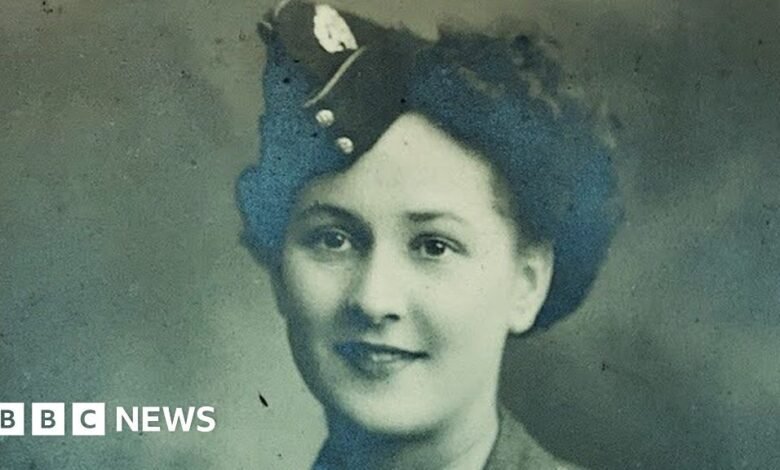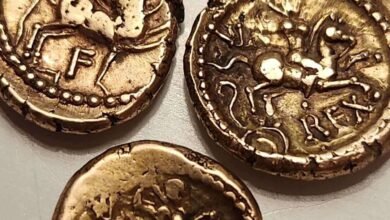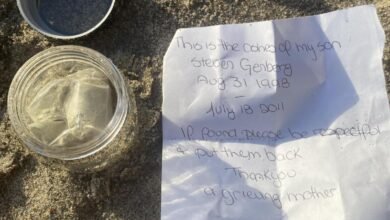Photographic Treasures Found Hidden in Texas Desk

image source, Leonard Chettle
- Author, Vanessa Pearce
- Role, BBC News, West Midlands
A collection of post-World War I photographs by a British photographer has been discovered in a piece of furniture in the United States.
Brad Knox said his wife, Anni, bought the striking desk in December at a sale near their home in Austin, Texas.
While searching for information about the furniture manufacturer, Prof. Knox found the prints after spotting a small crack in the desk.
“My six-year-old Sabine and I dug out all these papers that had fallen under the drawers and they turned out to be a series of photos that all seemed to be of the same person,” he said.
“Almost all of them have the Leonard Chettle – Nuneaton insignia at the bottom,” he explained.
“You are beautiful. They are clearly photos from a very talented photographer.”
The University of Texas computer science professor said he researched the name online and found the Nuneaton Local History Group website and associated Facebook group and contacted one of the administrators, Peter Lee.
After Prof. Knox posted the photos on the website, some people were able to identify relatives and even themselves in the images.
“The reactions were very interesting,” he said.
“Many people were interested in a piece of history being unearthed around the world.”
“My theory is that this furniture was used by Leonard Chettle to store photographs waiting to be picked up,” he added.
image source, Leonard Chettle
In response to the post, a woman identified a wedding photo from 1954 that featured her cousin Reg and his wife Margaret.
“The little flower girl is another one of my cousins, Jill,” she said.
A picture showing a soldier was identified as Colin Bower, a sub-lieutenant of the Indian Military Academy of the Madras Light Infantry.
image source, Nuneaton Local History Group
The photographer first opened a studio in Queens Road, Nuneaton, in 1912, Mr Lee explained, and worked for a time at Weddington Red Cross Hospital, where he photographed wounded soldiers returning from the First World War.
In 1917, Chettle joined the Royal Flying Corps (RFC) and worked as a reconnaissance photographer over the trenches.
A report in the Nuneaton Observer the previous year revealed that he had asked for permission to appeal his call-up, possibly a second time, but was refused.
“It must have been a dangerous job as RFC airmen did not survive long before being shot down, but he survived and joined the Royal Air Force in August 1918,” Mr Lee said.
Despite the end of the war, he was not released until April 30, 1920.
image source, Leonard Chettle
The photographer then returned to his studio and advertised his business as specializing in children’s portraits.
“I particularly like Leonard Chettle’s work because the images seem to have an ethereal clarity that almost captures the spirit of the subjects in his studio, in a way that some local photographers don’t quite achieve,” Mr Lee said.
“The photos of his children are particularly endearing.
“Many of the glass plate negatives he had kept from his reconnaissance missions over the trenches were destroyed.”
image source, Leonard Chettle
He continued to work until his retirement in the 1950s and must have devoted himself entirely to his business life, explained local historian and author David Fry.
“There were very few photographers who continued to do what he did for about 40 years,” Mr. Fry said.
He married in 1921 and had no children, he explained, “and so the business was his life, as much as anything else.”
He also offered a development service for people who took their own photographs, an occupation that flourished after World War I, he added.
The Queen’s Road Studio was subsequently taken over and no longer used in 1978.
Mr Lee said he had been unable to find any information about how the piece of furniture might have gotten from Nuneaton to Texas.
“So unfortunately it looks like we only have a fraction of a story and not a complete one,” he added.
There is very little of Chettle’s work in the Warwickshire Archives, but some images and blueprints for the conversion of his studios are included.
image source, Leonard Chettle
image source, Leonard Chettle
“It was fun to find out more about the history of this antique and it was a really pleasant surprise to hear from some of the people featured in the photos,” Prof Knox added.
“I was also fascinated to learn more about the city,” he added.
“One of the reasons I came forward on Facebook was out of idle curiosity, but also because the photos looked like they could be valuable to someone or a community.”
image source, David Fry/Leonard Chettle
Chettle’s surviving photographs are a “fascinating window into another world”, added Mr Fry, who has a collection of his images in postcard form.
“It’s like a little time travel.”



